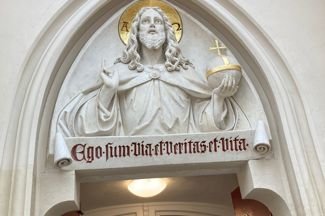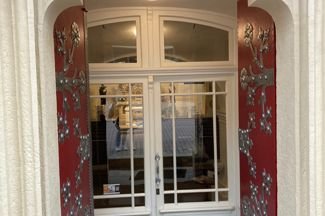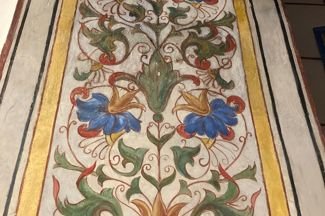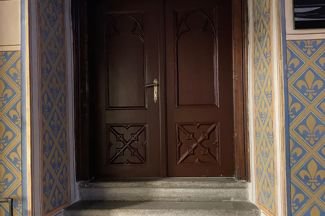Church of St. Elizabeth of Hungary or the Hospital Church?
The polygonal presbytery is evidence of the existence of a Hospital church from the beginning of the 14th century in Banská Bystrica.
Church of St. Elizabeth of Hungary was built as part of the city hospital in 1303. It was a smaller early Gothic building with a polygonal presbytery. Around the middle of the 15th century, the presbytery was covered with a cross rib vault, the buttresses of which are similar to those in the church in Slovenská Ľupča. The entire hospital, including the church, burned down in 1605, which led to significant reconstruction in 1748. In the 18th century, a new church was built in the north-south direction on the site of the original nave, and the Gothic sanctuary became a side chapel, consecrated by St. Anne.
The church acquired its current form in 1877 during the neo-Gothic reconstruction, which, among other things, created a new facade with two windows on the sides of the new entrance. The altar is the work of Jozef Murgaš. In addition to the rough structure of the presbytery and its vault, the triumphal arch and one window with an arched arch have been preserved from the medieval building. The church is administered by the Missionary Society of St. Vincent de Paul.
But let's take a closer look at the history of this beautiful church. Many buildings in the city, especially the older ones, have their names. Why do the residents of Banská Bystrica call this church the hospital? The answer is: In the past, it was part of the hospital, i.e. j. old hospital. The place of construction of the church was not chosen randomly. From its beginnings, it was part of the xenodochy and that determined its place. The term xenodochium corresponded to a shelter for travelers. This institution very quickly became an important part of various churches. There they took care of their travelers who traveled to holy places. Pilgrimages were difficult, so it is not surprising that they also brought the sorrows of injury and illness. Xenodochia were thus places where pilgrims regenerated and healed. It was a combination dormitory and hospital.
Their function also determined the location where the xenodochia were built. In the lower part of the city, between Banská Bystrica and Radvaň, passed the Magna via, one of the most important historical roads in the area, which branched off and several supra-regional and regional roads branched off from it. This great crossroads brought many wayfarers who traveled for weeks and months in the distant past. It became an advantage for the city, because most of these pilgrims were merchants who could do business here and thus were beneficial to the city either by selling domestic goods or by importing what was not available in Banská Bystrica.
In this period, Banská Bystrica was among the most modern cities in Slovakia at the time. It had many amenities, revolutionary at the time, such as water supply, sewerage, etc., but it did not have its own pharmacist, despite the fact that other cities already had one.
The first pharmacist known from archival materials is Ján Scherueb, who is mentioned in 1536. An entry from 1549 in the town's accounting book says that in that year the town already had its own doctor, who also had his own pharmacy. The health of the workers of the Thurzo-Fugger company, especially the disease called "morbus Gallicus", has been taken care of since 1496 by a doctor paid by the Fuggers. In 1526, the doctor Demeter and the pharmacist Andrej were supposed to take care of the health of the miners, and also ranhojici and greengrocers worked here. But how was the health care for this year? Archival materials may not have been preserved, but it is also possible that Banská Bystrica did not even need a pharmacist, because health and pharmacy were taken care of by monks from the Church of St. Elizabeth of Hungary. The hospital had its own economy, it owned two mills on the Bystrica stream. On July 15, 1524, he obtained a monopoly on grain milling. The church was managed by three hospital chaplains who looked after 24 poor people who were dependent on the care of their physical and mental needs. They also owned other properties such as a vineyard in Sebechleby, fields, meadows, gardens, their own livestock and also their own subjects.
Almshouse of St. Anna was a sister organization of the church of St. Elizabeth of Hungary. To this day, the mentioned chapel of St. Anna. Chudobinec had strict rules - no beggars, vagrants, or vagrants could stay there, but only poor people from Bystrica, who, however, did not become impoverished by their own doing. The poor were properly cared for, in addition to regular food, they received one denarius each week. The function of xenodochia has changed several times in history. The last blow came on April 17, 1605, when during Bočkaj's uprising, the xenodochium, as well as the mills and other buildings, were burned, but the almshouse of St. Anny remained unharmed.
In 1618, the construction of the new hospital began, but the church had to wait more than a century for its restoration. Only in 1748 was it built anew, and only the chapel of St. Anne and part of the sacristy that can still be seen today.



































































